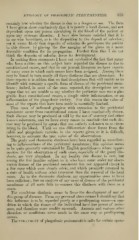Page 969 - My FlipBook
P. 969
ETIOLOGY OF PHAGEDENIC PERICEMEXTITIS. 979 ;
certainly true whether the disease is due to a fungus or not. The facts
I have given show conclusively that it is purely a local disease, and not
dependent upon any poison circulating in the blood of the patient or
upon any systemic disorder. I have also become satisfied that it is
in no wise hereditary, as is the disposition to the deposit of calculus
yet it seems likely that deposits of calculus do predispose the patient
to this disease by placing the free margins of the gums in a more
favorable condition for its propagation. Farther than this I do not
think the deposits of calculus favor its development.
In making these statements I have not overlooked the fact that many
who have written on this subject have regarded the disease as due to
constitutional causes, and that in our journal literature we have reports
of many cases in which such causes have been assigned. Among these
may be found in turn nearly all those diatheses that are obnoxious. In
these reports it is seldom that we find descriptions that will enable us to
identify with certainty a specific form of disease of the peridental mem-
brane ; indeed, in most of the cases reported, tlje descriptions are so
vague that we are unable to say whether the particular case was a gin-
givitis from constitutional causes, a simple calcic inflammation, or an
inflammation of the phagedenic variety. For this reason the value of
most of the reports that have been made is essentially limited.
That cases of inflamed gingivae with extension to the peridental
membrane occur from constitutional causes I have conclusively shown.
Such disease may be produced at will by the use of mercury and other
known substances, and we have every reason to conclude that such dis-
ease may be produced by agents that are entirely unknown to us circu-
lating in the blood. Until w'e can differentiate these forms from the
calcic and phagedenic varieties in the reports given us it is difficult,
however, to estimate the true value of the observations.
The gouty and rheumatic diatheses have been regarded as contribut-
ing to inflammations of the peridental membrane ; this opinion seems
to be quite generally entertained by English practitioners Avhose oppor-
tunities for the observation of such cases, especially of the gouty dia-
thesis, are very abundant. In my locality this disease is rare, but
among the few families subject to it who have come under my obser-
vation disease of the peridental membrane has not appeared except in
a few cases which w^ere clearly calcic, and which promptly returned to
a state of health without other treatment than the removal of the local
cause. As to the rheumatic diathesis, my opportunities seem to have
been sufficient ; but an analysis of my cases of disease of the peridental
membrane of all sorts fails to connect this diathesis with them as a
cause.
The scrofulous diathesis seems to favor the development of any of
this group of diseases. From my personal observations I should say that
this influence is to be regarded purely as a predisposing cause—a con-
dition in which the tissues of the individual have less power of resist-
ance, and therefore more readily succumb. Anaemia and various other
disorders or conditions serve much in the same way as predisposing
causes.
The TREATMENT of phagedenic pericementitis calls for certain opera-


